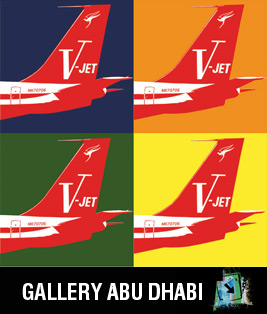 ast Forward: ABU DHABI ast Forward: ABU DHABI
Listen at art fairs around the world, and you’ll hear the United Arab Emirates (UAE) on everyone’s lips. With the construction of a modern art museum by Frank Gehry, a classical art museum by Jean Nouvel, a maritime museum by Tadao Ando and possibly a performing arts center by Zaha Hadid, all on its agenda—as well as an arts park—the capital city is aggressively building itself into a regional hub for global art.
 Perhaps most visibly, in 2012 the Guggenheim Abu Dhabi is scheduled to join its counterparts in New York, Las Vegas, Venice, Berlin and Bilbao as part of the world network of Guggenheim Museums. Like Bilbao, it will be designed by Frank Gehry, but, at nearly three times the size, it will be the largest Guggenheim in the world, with ample room for permanent collections, special exhibitions, a center for art and technology, a children’s art education center, a library and research center and a conservation lab. Perhaps most visibly, in 2012 the Guggenheim Abu Dhabi is scheduled to join its counterparts in New York, Las Vegas, Venice, Berlin and Bilbao as part of the world network of Guggenheim Museums. Like Bilbao, it will be designed by Frank Gehry, but, at nearly three times the size, it will be the largest Guggenheim in the world, with ample room for permanent collections, special exhibitions, a center for art and technology, a children’s art education center, a library and research center and a conservation lab.
What hasn’t been fully determined is the extent to which the creativity of the UAE and its neighbors will appear in the Guggenheim’s vast spaces.
“Our objective is to make the museum relevant to the region,” says Thomas Krens, director of the Guggenheim Foundation and head of the partnership with Shaykh Sultan bin Tahnoon Al Nahyan, chair of the emirate’s Tourism Development and Investment Company. But with the project yet to break ground, “we are still at the beginning stages of what we want this museum to be.”
More controversial has been the emirate’s plan to collaborate with the Louvre on Jean Nouvel’s classical art museum, which some in France’s art elite have criticized for appearing to be motivated more by economics than artistic or cultural strategy.
However, Art Paris—the largest annual contemporary-art fair in France—is franchising an annual sale in the emirate with unabashed business and cultural ambitions, the latest of what are now more than half a dozen major regular arts events. In late November, some of the world’s leading galleries will convene in Abu Dhabi bearing works of western masters from Picasso and Matisse right through today’s rising Gulf-region artists, giving the UAE a home-turf view of “the extent of the panorama of art around the world,” says Caroline Lacoste, co-founder of Art Paris. Under the patronage of the crown prince of Abu Dhabi, Shaykh Mohammed bin Zayed Al Nahyan, the event is part of the emirate’s strategy to build up art appreciation.
The roots of Abu Dhabi’s arts scene go back to the early 1980’s and the opening of the Abu Dhabi Culture and Heritage Authority (ADCH) and its Cultural Foundation. From the Spanish tenor José Carreras to 19th-century European orientalist paintings, a variety of exhibits, workshops, lectures, concerts, films and festivals has made the Cultural Foundation a haven for artists and art-lovers and a prototype for emerging events on a blockbuster scale.
back to top |